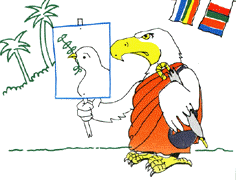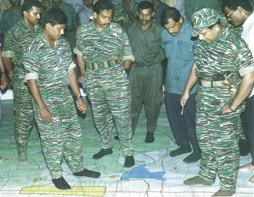Velupillai Prabhakaran 
Maha Veerar Naal Address
மாவீரர் நாள் - National Heroes Day
National Heroes Day - November 27, 1999 1.English Translation of Address
2.Address in Tamil
English Translation of Address Though the LTTE stands today as a formidable force
with the military capability to liberate our homeland, we have not abandoned the path of peace. We want to resolve the Tamil conflict through peaceful means; through civilised methods without recourse to bloodbath and destruction of life...
My beloved people of Tamil Eelam,  "Today is Maha Veerar Naal... "Today is Maha Veerar Naal...
...Our current military successes have surprised and astounded the world. This is a unique historical achievement in the art of contemporary warfare. The dimensions of this military victory have not only amazed our enemy but also astonished several international countries that have been actively helping Sri Lankas war effort by providing training, arms and funds.
The vast tracts of fertile lands of Vanni, which were invaded and occupied by the Sinhala armed forces afters years and months of massive military campaigns, after sacrificing thousands of lives, have been liberated by our fighters at a rapid pace within a short span of time. A colossal military structure with its multiple military complexes, well fortified bases and camps suddenly collapsed with the onslaught of the Tiger offensive. We have liberated almost all the ancient strategic towns in the Vanni region. I am happy that we have redeemed a sector of Manal Aru, which is the heartland of Vanni where the states army massacred the indigenous Tamils and created Sinhala settlements.
Our massive offensive campaign in Vanni code-named Unceasing Waves 3 has effectively demonstrated to the world the extra-ordinary growth and development of the Tiger fighting forces in the art of modern warfare. The speed of our strikes, the ability of rapid deployment, the unified command, the high discipline, the spectacular offensive tactics and the tremendous courage displayed by our fighting formations have astounded the world military experts.
This war is being waged for liberation of our land. Tamil Eelam is our homeland, a land which belongs to us historically, a land on which we were born and bred, a land of our sustenance and resources, a land that forms the very foundation of our national identity. Our enemy claims that this land belongs to him.
For more than fifty years - ever since the Sinhala chauvinists assumed political power in the island- the lands of the Tamils have been systematically usurped. Our land has been subjected to tyranny and oppression. On one side, there have been devious schemes by which our lands have been forcefully annexed and given to Sinhala colonisers. On the other hand ,our lands have been militarily occupied and their resources destroyed and the people who lived on those lands have been reduced to the state of destitution. It is against this injustice we have been fighting. Therefore our liberation war is essentially a war to liberate our lands and to establish our sovereignty: our right to rule in our homeland.
Our people have now understood the aim and objective of this liberation war. Our people, who have lost their lands and the livelihood that derived from the lands and have become destitute, realise the value and significance of their own lands. They also realise the necessity of chasing away the alien forces that have invaded and occupied our territories. It is because of this realisation wide sections of the popular Tamil masses are supporting and participating in this war of liberating our homeland. Our liberation war has now expanded and developed into a higher stage as the peoples war of liberation.
In my annual speeches on the Martyrs Day, I have always emphasised the importance of peace and peaceful ways of seeking a negotiated political settlement. At the same time, I have also pointed out the fact that Sinhala Buddhist chauvinism was not prepared to resolve the ethnic conflict through peaceful means.
The two major Sinhala political parties, who have assumed political power alternatively in the Sri Lankan political system, are essentially chauvinistic organisations. Both these political parties have bred and flourished in the anti-Tamil Sinhala Buddhist racist ideology. For the last half a century these parties competed with each other in intensifying the oppression against the Tamil people. In this diabolical history of racist oppression it is Chandrikas regime which has inflicted the worst form of tyrannical oppression.
The five-year rule of Chandrika has been a curse on the Tamil people. The monumental tragedy that our people encountered in the form of war, violence, death, destruction, displacement, hunger and starvation was the worst form of tyranny ever suffered by the Tamils. Chandrikas oppressive rule marks an epoch consisting of blood stained pages of our history. Her tyrannical rule left a permanent scar on the soul of the Tamil nation.
While masterminding an authoritarian tyrannical rule against the Tamils internally, Chandrika Kumaratunga portrayed herself internationally as a goddess of democracy committed to peace. Having implemented a notorious military programme aimed at the total invasion of the Tamil homeland she interpreted her project as a war effort for peace. The entire international community believed her and supported her military project. In this deceptive disinformation campaign to cheat the world, treacherous Tamil elements played a crucial role. internationally as a goddess of democracy committed to peace. Having implemented a notorious military programme aimed at the total invasion of the Tamil homeland she interpreted her project as a war effort for peace. The entire international community believed her and supported her military project. In this deceptive disinformation campaign to cheat the world, treacherous Tamil elements played a crucial role.
We do not trust Chandrika. She does not have the honesty and determination to resolve the Tamil national conflict in a fair and reasonable manner. We perceive her as a modern representative of a neo-Sinhala-Buddhist chauvinism. It is for this reason we refused to engage in a direct dialogue with her. Yet, we did not close the doors for peace. I made an announcement last year in my Martyrs Day message that we were prepared for peace talks with the assistance of international third party mediation.
Though we called for third party mediation we have emphasised the necessity of creating certain objective conditions conducive for peace talks. We explained very clearly that these objective conditions entail a situation of normalcy free from military aggression, occupation and economic strangulation of the Tamil nation.
Chandrikas government refused to accept our proposal for creating a congenial peaceful atmosphere for peace talks. Chandrika was not prepared to bring an end to the war, to stop the military aggression of our land and to lift the economic blockades. The government wanted to use the military campaigns and the economic embargoes as political pressures on the Tamils.
The concept of the war for peace as enunciated by Chandrikas government signified a military solution. This grand military project aimed at a total invasion of the Tamil homeland and envisages the defeat of the Tamil Tiger movement and finally the eventual subjugation of the Tamil nation. Chandrika worked tirelessly for the last five years to implement her military scheme. Though the project brought about severe setbacks and debacles to the armed forces, she was determined not to abandon her military programme. Therefore, she did not reflect seriously about peace nor has she taken any constructive steps towards peace talks.
Chandrika conveyed to us a message through third party source that she was prepared to hold secret talks with certain conditions while continuing the war effort. We rejected her proposal. It is absurd and practically impossible to hold peace talks on one side while engaging in a bloody war on the other side. It is an extremely difficult task to involve in a friendly dialogue with the enemy while our people are subjected to death, destruction and suffering. Furthermore, we do not want to engage in a negotiating process with conditions and time frames. Chandrika did not sincerely extend her hand of friendship. She wanted to lay a trap under the cover of peace talks. But we were not prepared to fall into that peace trap.
 Swept by the Unceasing Waves of the Liberation Tigers, Chandrikas military project crumbled as a house of sand built on the seashore. The spectacular victories that we gained in this current offensive campaign have turned the balance of military power in our favour. The massive effort made by Chandrika over the last five years to weaken the LTTE and to achieve military hegemony was shattered by us in the matter of a few days. Swept by the Unceasing Waves of the Liberation Tigers, Chandrikas military project crumbled as a house of sand built on the seashore. The spectacular victories that we gained in this current offensive campaign have turned the balance of military power in our favour. The massive effort made by Chandrika over the last five years to weaken the LTTE and to achieve military hegemony was shattered by us in the matter of a few days. Though we stand today as a formidable force strengthened by manpower, firepower, moral power, and peoples power and have the military capability to liberate our homeland, we have not abandoned the path of peace. We want to resolve the Tamil conflict through peaceful means, through civilised methods, without recourse to a bloodbath and the destruction of life.
We wish to re-iterate that peace talks should be held in a cordial peaceful atmosphere of mutual trust and goodwill with the assistance of international third party mediation. By peaceful atmosphere we mean a condition of normalcy characterised by cessation of hostilities, withdrawal of troops occupying Tamil lands and the absence of economic blockades.
We cannot allow the Sinhala State to use the conditions of war, military aggression of our lands, and economic blockades as tactics of pressure against the Tamils. We wish to engage in peace talks as equals with mutual understanding in a cordial environment without external coercion and constraints.
We are keeping the doors of peace open and are sending signals of peace and goodwill to the Sinhala nation. But we are aware that Sinhala political leadership will not agree to create a peaceful environment as we suggest. We are also aware that Sinhala chauvinistic leadership will not easily abandon their longstanding policy of military violence and repression against the Tamils. Therefore we do not live in fantasy hoping to resolve our national conflict by engaging in a rational dialogue with Sinhala political leadership.
The anti-Tamil Sinhala racist political system - which totally disregards human rights and liberties - offers no alternatives to the Tamils other than to fight, secede and establish an independent Tamil state. It is along this secessionist path that the Sinhala nation is driving the Tamil nation.
Years ago our people made a decision that an independent state of Tamil Eelam is the only and the final solution to our national conflict. For the last several years, our freedom movement has been fighting a bloody liberation struggle carrying the cross of our peoples aspirations for freedom. Today we have reached a turning point in this long historical journey towards emancipation.
|